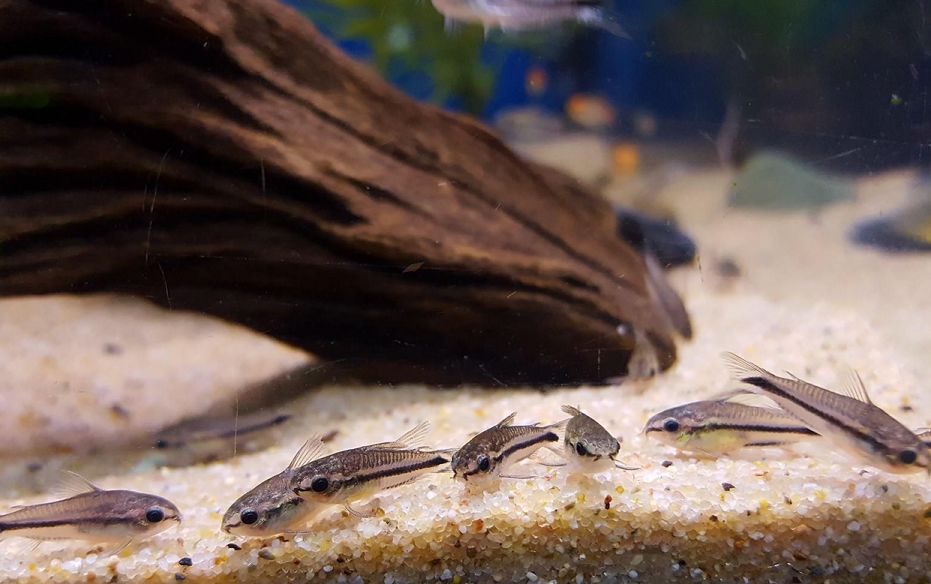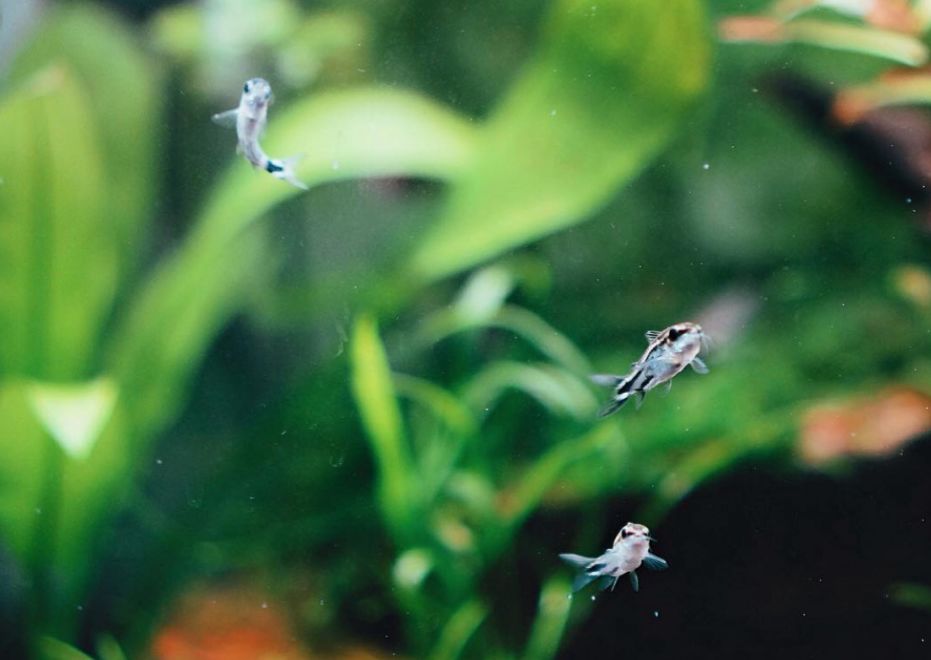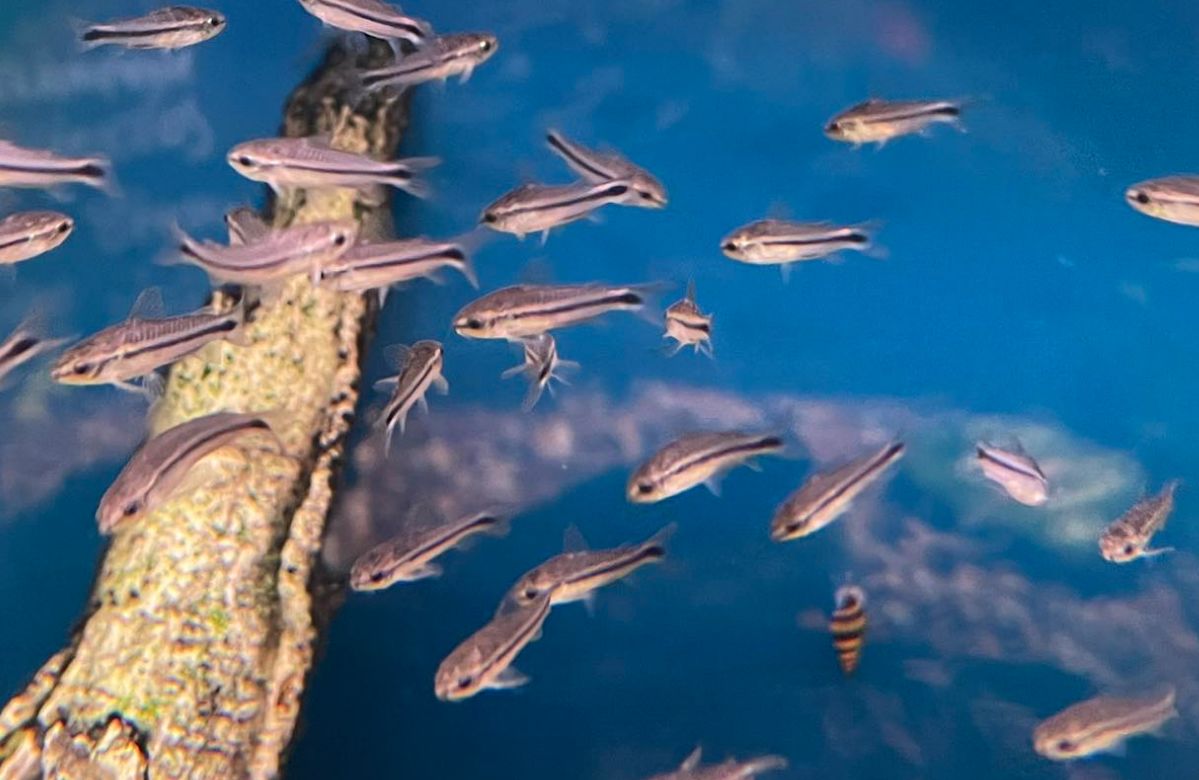Many new species of catfish from the Corydoras genus have been discovered recently, including the pygmy corydoras. This fascinating little fish, known for its diminutive size, is a delightful addition to any aquarium. While it may not boast the bright colors found in some other fish, its compact stature is a significant advantage. Pygmy corydoras thrive in smaller setups, making them ideal for nano tanks.
This species typically grows to about an inch in length, allowing aquarists to keep them in groups even in limited space. Their peaceful nature makes them compatible with a variety of tank mates, further enhancing their appeal. When considering a suitable environment, ensure the tank is well-planted with gentle filtration to mimic their natural habitat, providing both hiding spots and open swimming areas.

Contents
Habitat in the wild
The pygmy corydoras belongs to the Callichthyidae family, commonly referred to as armored catfish or cory catfish. These small and peaceful fish are part of the Corydoras genus, which includes various species of catfish frequently kept in aquariums. Pygmy corydoras are popular among aquarists due to their diminutive size, engaging behaviors, and their beneficial role in keeping the aquarium substrate clean by scavenging for leftover food.
Pygmy corydoras are native to South America and are endemic to the Madeira River in Brazil. This region features flooded forests, where the river water is typically muddy and the current is slow and nearly imperceptible. These catfish are often observed swimming in large schools, seeking refuge among the riverside vegetation and the roots of trees, which provides them with security and ample foraging opportunities.
In their natural habitat, pygmy corydoras thrive in slow-moving waters, including small creeks, tributaries, and flooded forest areas. Their environment is characterized by soft, acidic water rich in vegetation, submerged branches, and leaf litter. The water temperature in their native range generally falls between 72°F and 78°F (22°C to 26°C), with a slightly acidic pH level usually between 6.0 and 7.0.
These fish prefer well-planted aquariums that replicate their natural conditions, as this encourages their natural behaviors. Providing a substrate of fine gravel or sand helps them forage effectively. Pygmy corydoras are also social creatures, thriving in groups of six or more, which enhances their sense of security and promotes more dynamic interactions within the tank. Their peaceful demeanor makes them suitable companions for other small, non-aggressive fish species in community aquariums.

Description
Color
The pygmy corydoras displays an olive drab body with a silvery tint, creating a striking yet subtle appearance. The back of the fish is darker than the abdomen, enhancing its visual contrast. A prominent black horizontal stripe runs along the sides of its body, tapering near the tail fin where it widens into an oval shape. Below this stripe, a thinner black line extends from the anal fin to the abdominal fin. The fish also features a pair of barbels on both the maxilla and mandible, aiding in its foraging behavior. All the fins of this catfish are transparent, adding to its delicate and appealing look.
Size
Pygmy corydoras typically reach a size of up to 3.2 centimeters (1.3 inches), although they commonly remain around 2 to 2.5 centimeters (approximately 1 inch) in length. Their small size makes them an excellent choice for aquarists, especially in smaller aquariums or community tanks featuring other peaceful fish. Despite their diminutive stature, these fish exhibit fascinating social behaviors, contributing to the lively atmosphere of a well-maintained aquarium. Their compact size means they require less space compared to larger species, but it’s essential to provide an environment that closely mimics their natural habitat to ensure their health and happiness.
Lifespan
The lifespan of pygmy corydoras typically ranges from 3 to 5 years in a well-maintained aquarium. However, various factors can influence their longevity, including water quality, diet, tank size, genetics, and overall care. Creating suitable living conditions, providing a balanced diet, and maintaining a stress-free environment are crucial for maximizing their lifespan. Regular water changes, effective filtration, and keeping them with compatible, non-aggressive tank mates also play significant roles in promoting their overall health and well-being, ultimately enhancing their longevity in captivity.
| Characteristic | Description |
|---|---|
| Scientific Name | Corydoras pygmaeus |
| Common Name | Pygmy Corydoras, pygmy cory, dwarf corydoras |
| Family | Callichthyidae (Armored catfish or Cory catfish) |
| Origin | Amazon River basin, South America |
| Adult Size | Around 1 inch (2.5 cm) |
| Lifespan | 3 to 5 years |
| Tank Size | At least 10 gallons (38 liters) |
| Water Temperature | 72°F to 78°F (22°C to 26°C) |
| pH Range | 6.0 to 7.0 |
| Water Hardness | 2 to 8 dGH |
| Behavior | Peaceful, social, and active |
| Diet | Omnivorous – They eat small invertebrates and algae |
| Tank Level | Bottom-dweller, occasionally mid-level swimmers |
| Compatibility | Peaceful, suitable for community aquariums |
| Group Size | Preferably kept in groups of 6 or more |
| Breeding Difficulty | Moderate |
Difficulties in keeping
The pygmy corydoras is not very demanding, peaceful and it doesn’t require roomy tanks. It can be recommended to both professionals and beginners as well as it can be kept in community tanks.
Keeping in a tank
Tank Size
To accommodate a small school of pygmy corydoras, a tank with a volume starting from 10 gallons (approximately 38 liters) is sufficient. However, as the size of the school increases, a larger tank becomes necessary. These small catfish are social and thrive in groups, so a more spacious environment is beneficial for their well-being. A larger tank provides ample swimming space, better maintenance of water quality, and reduces territorial disputes among fish.
In a 10-gallon tank, you can comfortably keep a group of 6 to 8 pygmy corydoras. If you intend to house a larger group or include other fish species, consider opting for a tank that is at least 20 gallons (approximately 76 liters) or more. Beyond tank size, it’s essential to create a suitable environment that includes plenty of hiding spots, the right substrate, and stable water parameters to promote the health and happiness of your pygmy corydoras.
Water Parameters
In their natural habitat, pygmy corydoras thrive in water with specific parameters: a pH level of 6.0 to 7.0, water hardness of 2 to 5 dGH, and temperatures ranging from 72°F to 78°F (22°C to 26°C).
Recommended water parameters for pygmy corydoras are as follows:
- Temperature: 72°F to 78°F (22°C to 26°C). Maintaining a warm environment within this range is crucial for their comfort.
- pH Level: 6.0 to 7.0. These catfish are adapted to soft, slightly acidic water, making it vital to keep the pH within this range for optimal health.
- Water Hardness: 2 to 8 dGH (degrees of general hardness). Pygmy corydoras prefer low to moderate hardness levels in their environment.
- Ammonia, Nitrite, and Nitrate Levels: Ammonia and nitrite levels should be maintained at 0 ppm, as these substances are toxic to fish. Ideally, nitrate levels should remain below 20 ppm to prevent water quality issues.
Regularly using a reliable water test kit to monitor these parameters and making necessary adjustments will help ensure the health, longevity, and overall well-being of your corydoras.
Tank Decor
For the tank substrate, both small pebbles and large-grained sand are suitable options, provided the sand is free-running and crumbly. Avoid sharp-edged substrates, as they can damage the catfish’s barbels, hindering their ability to find food. Adding smooth stones can also provide resting spots for the fish.
Decorative elements such as driftwood, flower pots, and coconut shells not only enhance the tank’s aesthetics but also offer shelter for the fish. Incorporating tank plants will contribute to a greener environment while providing additional hiding spots. Pygmy corydoras prefer dim lighting, so placing plants along the tank perimeter is ideal, leaving open swimming space. Plants with broad, horizontal leaves are particularly beneficial, allowing the catfish to rest comfortably.
Filtration
Pygmy corydoras possess intestinal respiration capabilities, allowing them to breathe atmospheric air through their modified intestinal tract when oxygen levels in the water are low. Therefore, providing easy access to the water’s surface is essential. While a water filter is necessary for maintaining water quality, it doesn’t have to be a high-flow canister filter, as excessive water movement can be stressful for these small fish. Aeration is generally not required. Weekly water changes of about 1/3 of the total volume are recommended to keep the environment healthy.

tank mates
In the wild pygmy corydoras live in small schools, that’s why in a tank they feel secure and comfortable in a school if at least 5-6 fish and 5-10 will be even better. Though most of their relatives are bottom-dwellers, corydoras like spending much of their time in a middle water layer.
In a well-populated group, these tiny catfish will feel more secure, display natural schooling behavior, and generally be less stressed. A larger group also provides a more interesting and dynamic display in the aquarium, as they interact with each other and move together in a coordinated manner.
They are very peaceful and good-tempered tank mates, but considering their small size they should live with peaceful fishes of the same size:
- Harlequin Rasboras (Trigonostigma heteromorpha)
- Neon Tetras (Paracheirodon innesi)
- Ember Tetras (Hyphessobrycon amandae)
- Glowlight Tetras (Hemigrammus erythrozonus)
- Black Neon Tetras (Hyphessobrycon herbertaxelrodi)
- Cardinal Tetras (Paracheirodon axelrodi)
- Rummy Nose Tetras (Hemigrammus rhodostomus)
- Dwarf Gouramis (Trichogaster lalius or Trichogaster chuna)
- Sparkling Gouramis (Trichopsis pumila)
- Celestial Pearl Danios (Danio margaritatus)
- White Cloud Mountain Minnows (Tanichthys albonubes)
- Dwarf Rasboras (Boraras spp.)
- Endler’s Livebearers (Poecilia wingei)
- Guppies (Poecilia reticulata)
- Platies (Xiphophorus spp.)
- Corydoras Catfish (Corydoras spp. – panda cory, adolfoi catfish)
- Otocinclus Catfish (Otocinclus spp.)
- Bristlenose Plecos (Ancistrus spp.)
Diet
Pygmy corydoras have a diverse diet and eagerly consume various types of food, including plant-based options, dry pellets, flakes, as well as live and frozen foods. They particularly enjoy tubifex, daphnia, brine shrimp, and cyclops. Due to their small mouths, it is essential to feed them in tiny portions, ensuring that the food is manageable. These catfish primarily forage along the tank bottom, scavenging for food on substrate and plant leaves, and they may even venture to the water’s surface to feed.
Being most active at night, pygmy corydoras benefit from multiple feeding sessions. One evening meal might not suffice, so it’s also suitable to feed them during the day. Since they eat slowly, it’s important to avoid letting uneaten food linger on the tank bottom for extended periods, as this can lead to water quality issues.
Gender Differences: Male vs. Female
Distinguishing between male and female pygmy corydoras can be somewhat challenging due to minimal sexual dimorphism, which means that physical differences between the sexes are subtle. However, certain characteristics can aid in differentiation:
- Size: Females may be slightly larger and have a broader body compared to males, though this difference is not always noticeable.
- Body Shape: Females may exhibit a rounder, fuller belly, especially when carrying eggs, while males generally appear slimmer.
- Coloration: Some aquarists note that females might appear darker in coloration than males, but this can vary and is not a reliable method for sexing.
- Vent Position: The most dependable way to determine sex is by examining the vent, located behind the pelvic fins. Mature females typically have a rounder, broader vent, while males have a more pointed, narrower vent.
These differences can be subtle, making accurate sexing of pygmy corydoras challenging without experience or when observing a group, which allows for easier comparison.
If breeding pygmy corydoras is of interest, watching their behavior during spawning can help identify males and females. Females will lay eggs, and males will fertilize them, providing a clearer distinction. In a typical community aquarium, however, knowing the sex of pygmy corydoras may not be essential, as both genders exhibit similar behavior and care needs.

Breeding Pygmy Corydoras
To stimulate breeding in pygmy corydoras, maintain optimal tank conditions by performing frequent water changes of up to 50% of the total volume. Gradually raise the water temperature by 2-3 °C and ensure intense aeration, as these factors encourage spawning. Additionally, an increase in atmospheric pressure can also promote breeding behaviors. A well-planted tank with at least 12 pygmy corydoras will create a suitable environment for successful breeding.
Pygmy corydoras do not eat their eggs, so there’s no need to separate the female into another tank. Instead, focus on providing proper nutrition for the juveniles once they hatch. However, if your school is smaller or includes other tank inhabitants, it’s advisable to set up a separate spawning tank.
Spawning Tank Setup
A spawning tank with a capacity of 2.6 gallons (10 liters) is sufficient. For effective breeding, maintain a ratio of 1 female to 2-3 males. It’s beneficial to keep males and females separately for a week prior to spawning to prepare them for the breeding process.
Courtship Behavior
Before spawning, a “courtship” period occurs where the male displays vibrant colors and dances in front of the female to attract her attention. Once she shows interest, the male touches her with his barbels, leading to the classic “T-position,” where the male positions the female’s barbels between his pectoral fins and body.
During this intimate moment, the female collects the male’s milt in her mouth and simultaneously spawns 2-5 eggs into her abdominal fins. She then searches for an appropriate spot—such as a tank wall or plant leaves—to lay the eggs. After cleaning the selected area, she applies milt to it and deposits between 30 to 50 eggs.
Post-Spawning Care
After spawning, remove the adult fish from the tank and raise the water temperature by 2-3 °C to encourage hatching. To prevent fungal infections on the eggs, you can add a small amount of methylene blue to the water.
In 3-4 days, the pygmy corydoras juveniles will emerge. For the first 3 days, they will rely on their yolk sacs for nutrition. After that, you can introduce dry food specifically for juveniles, infusoria, and later progress to brine shrimp nauplii and nematodes.
Juveniles typically reach reproductive maturity at around 8 months of age, with males often maturing slightly earlier than females. This growth period allows them to integrate into a community setup, enriching the aquarium’s dynamic.